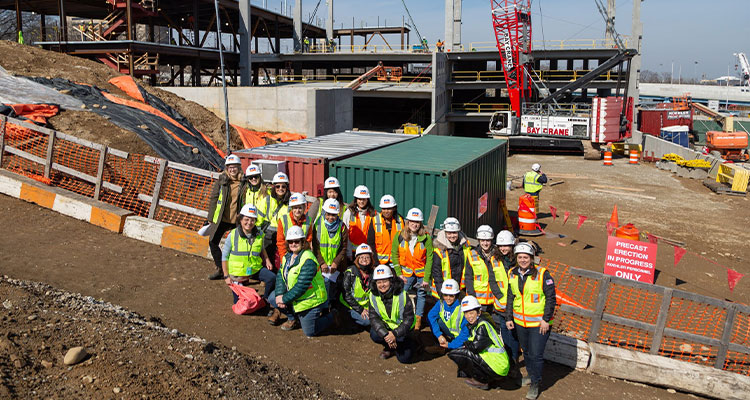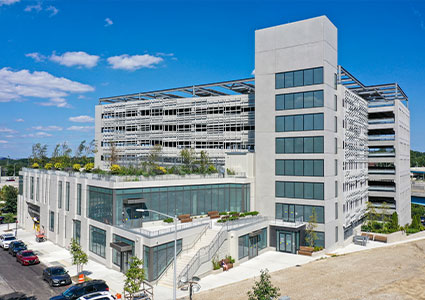
Lisa Washington discusses design-build: once considered alternative, it is now mainstream, fueling innovation, delivering collaboration, and elevating outcomes
I’ve been at the Design-Build Institute of America (DBIA) for just over 20 years,” Lisa Washington begins. “I joined in 2004 as Vice President of Education & Conferences at a time when the organization didn’t have a robust education program. The design-build sector accounted for less than 20 percent of construction spending, so there wasn’t a huge audience. DBIA was struggling to figure out how education could play a role in advancing design-build, so I was hired to try and address the problem. I got promoted to Chief Operating Officer about five years later and then when the then CEO retired in 2009, I was promoted to Executive Director/CEO.”
Indeed, the organization has seen record growth in its education and certification programs under Lisa’s leadership. Membership among owners, practitioners and young professionals continues to grow and DBIA has earned the reputation as the nation’s number one resource for design-build research, thought leadership, advocacy and training.

Lisa has more than 20 years of association management experience, with a Certified Association Executive credential, bachelor’s in business administration and a master’s in nonprofit management from the University of Maryland. In 2012, she was named one of Engineering News-Record’s Top 25 Newsmakers of the Year and was inducted into the National Academy of Construction in 2023.
“Prior to joining DBIA,” she continues, “I worked for the independent Electrical Contractors Association as Vice President of Membership. So, my career has been in the nonprofit association field, not necessarily in design and construction, but I have, to a large degree, been drawn to the design and construction industry, probably because my grandfather, my father and my brother are all contractors. So, I’ve always been around that industry and find it fascinating. Fast forward to today, and education is at the heart of what DBIA does. For an organization that had very little education in 2004, it now brings in almost half of its revenue from education, most of which is reinvested to develop new programs as the industry evolves.
“When I joined DBIA, less than 15 states had a design-build authority, whereas today, all but two states have some level of design-build authority in the public sphere. Today, DBIA has indicated that design-build is about 44 percent of construction spending and is projected to be about 47 percent by 2028. So, this collaborative delivery method really is the way for the future.”
Indeed, in 1993, design-build was considered a radical approach to project delivery and design-builders were seen by many in the industry as a threat to the status quo. A small group of visionaries who believed there was a better way to build established DBIA. These founding fathers committed to changing the way the construction industry delivers projects by promoting the collaboration, innovation and efficiency of cost and schedule inherent in design-build. In the three decades since, design-build has become the nation’s fastest-growing delivery method, and DBIA is the nation’s leading source of education, resources and advocacy for Design-Build Done Right®.
“While we are a membership organization,” Lisa continues, “the message I like to get across is that we’re an educational institution first and foremost. Membership means you have a group of people with a common interest, but at the heart of what we do is generating engagement with design-build, and an understanding of the best practices that result in optimal outcomes. People can join as individuals or organizations. They’re typically interested in meeting other people who could potentially be partners on future design-build projects or are owner-organizations looking to engage in design-build. We provide a unique forum for networking among people who have embraced design-build project delivery to achieve better outcomes.
“We have about 8000 members right now and our conferences are the primary vehicle for facilitating networking, usually with about 2500 attendees. We host an expo featuring approximately 200 exhibitors and have a network of 15 affiliated regions. There can be nuances to design-build implementation between different regions, but we focus on best practices that apply in any area.
“Research has consistently shown that design-build is twice as fast as the more traditional design-bid-build approach,” she shares. “It also results in about four percent less cost growth, which might not seem like a big number, but if you take it against a multi-million or -billion-dollar project, that’s a huge amount of money. So, there’s speed of delivery, value for money, and less cost growth. We never say design-build is cheaper because that’s not always the case, but it is the best value for money. It’s also proven to deliver more exceptional outcomes because the design-build process involves early collaboration and integration, which drives innovation and problem solving, creating more resilient and sustainable buildings.
“New York City, for example, is such a major metropolitan area with so much need for infrastructure improvement, but it was only in 2018 when the area received design-build authority, with the NYC Department of Design and Construction (NYC DDC) completing their first design-build project in 22 months. This was less than half the time expected under the old low-bid system, with cost savings reported as $12.9 million. Not one cent of the $9.5 million contingency fund was touched. NYC DDC recently reported that the city is saving 50 years of project time and $1.4 billion on 42 current capital projects that are using design-build. This has been compared to similar scope and size projects undertaken using the old method. So, the city is sold on the design-build concept, which is its delivery method of choice. This is a compelling example of the power of design-build,” she enthuses.
Comprehensive education
Alongside conferences and events, DBIA hosts its Design-Build Project/Team Awards, the winners of which set themselves apart in the industry as the nation’s best design-build projects and teams. The awards honor the teams and projects that raise the bar and demonstrate what Design-Build Done Right® can achieve.
“To even qualify to enter,” Lisa elaborates, “a project must be on or ahead of schedule, on or under budget and exceeding owner expectations. All the projects are great, but we look for the best of the best. One such project was the National Renewable Energy Laboratory (NREL) which won the Enlightened Owner award.”
great, but we look for the best of the best. One such project was the National Renewable Energy Laboratory (NREL) which won the Enlightened Owner award.”
With 15 years of using firm fixed-price performance-based design-build, NREL has continuously evolved its methodology, applying lessons learned and best practices. This expertise allowed it to deliver the Research and Innovation Laboratory (RAIL) project on time and within budget, even amid pandemic challenges. It formed a robust integrated project team with key stakeholders, ensuring that diverse perspectives were considered. Structured partnering sessions, feedback loops and an executive steering committee, maintained alignment and strategic vision.
“NREL made sure that its requirements were written in performance-based specs for the contract because that’s key to design-build too,” she adds. “Prescriptive specs don’t leave room for innovation, so it’s important to share goals, challenges and constraints, but let the team provide the solutions. NREL is particularly open to this way of working and has refined its process over time, starting with its first net-zero building constructed in 2010.
“Additionally, we have a strong focus on virtual design and construction (VDC), which helps to coordinate the process across the team. While VDC or technology can enhance any project delivery method, you tend to get optimal results in design-build because of the early team collaboration. Some people think technology solves the problem, but we think it’s people, process and then technology. Technology isn’t always the answer alone and we advocate this approach, so much so that we introduced a new member of staff to help to educate the industry on this topic.
“Similarly, sustainability is always elevated in the design-build process. Some owners believe it’s too costly to incorporate sustainability, so we released a position statement on design excellence about 18 months ago. We talk about what design excellence is and one of the lenses through which we look at it is sustainability. Design-build teams have a responsibility to help guide the owner in this area, to educate them, and to alleviate concerns that sustainability is too costly. Our position used to be that owners need to clearly articulate their sustainability goals. We have since switched that position to suggest that design-builders are driving the future of resilient and sustainable infrastructure,” Lisa shares.
As the only association representing the entire spectrum of design and construction professionals, DBIA represents everyone who has a stake in the future of the industry. Members receive access to education and certification that inspires both projects and futures. By promoting the value of design-build project delivery and teaching the effective integration of design and construction services, DBIA ensures success for members across all disciplines.
“Our comprehensive education offerings are designed to cater to individuals and teams, providing them with the tools they need to succeed,” Lisa continues. “With both virtual and in-person options, earning continuing education hours has never been easier. We have gone from an organization that tried to explain to people what design-build is to advocating legislative authority, and now, sharing best practices. We’re teaching what’s next in terms of elevating design-build to the next level of performance.”
The rapid growth of design-build presents the need for leaders who can deftly navigate the unique landscape of collaborative project delivery. Projections show that nearly half of all construction spending will be design-build by 2028, so building a strong foundation of leadership is vital to keeping up with that trend. DBIA’s Collaborative Delivery Leadership Academy, in partnership with Barbara Jackson, LLC, is designed to equip AEC professionals with the leadership skills and mindset needed to successfully make the mental shift from a segregated services approach to an integrated one.
“I think design-build is so much more than just a single point; it’s a mental and cultural shift. Early integration and a streamlined and aligned decision making process within the owner culture is essential. It’s surprising how the concept of trust in collaboration and one team, one goal isn’t as common as you’d imagine. Some are turning to consultants or what we call owner advisors to help guide them through the process. What DBIA is trying to highlight is that a consultant who worked in a design-bid-build environment doesn’t automatically translate to one who can be an advisor in a design-build environment. It’s a completely different skill set, and owners need to ensure an advisor is well-versed in that cultural and mental shift,” she concludes.